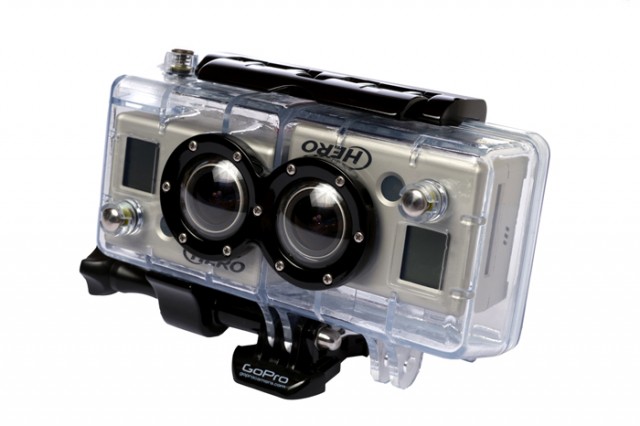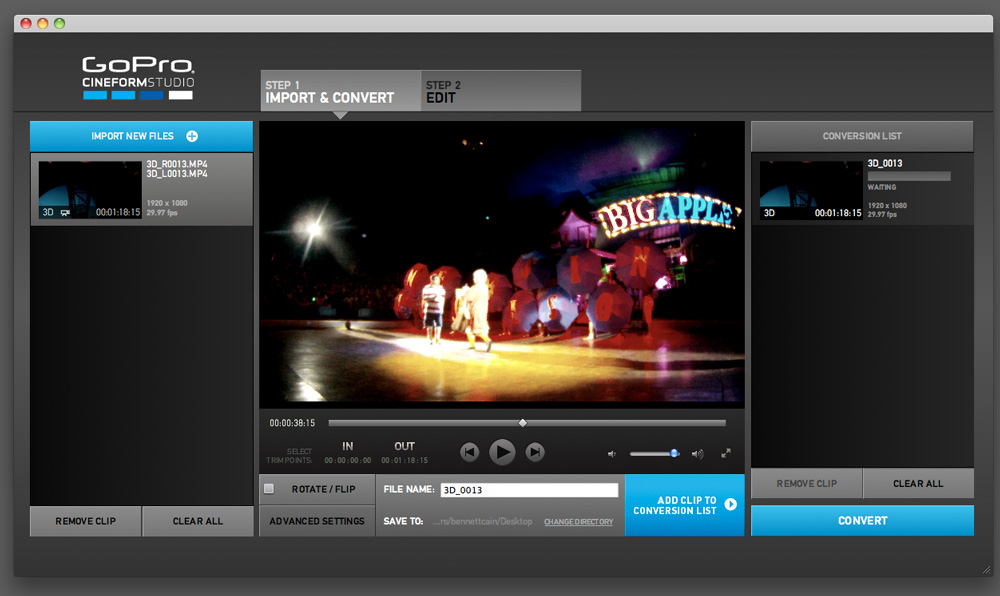A few thoughts - GoPro Cineform, Dashwood 3D, LUT Buddy
/A few thoughts - GoPro Cineform, Dashwood 3D, LUT Buddy
Hope everyone had a good Rapture. I know I did and I'm looking forward to the next one.
I'll be down the work rabbit hole for the next few months so updates to this site will continue to be sporadic at best. But today's a lazy Sunday and I've been playing around with some new toys and had a few thoughts I'll throw at ya.
3D GoPro -
I took one of these to the Big Apple Circus in Queens yesterday to do some tests for an upcoming stereo shoot. This camera could really benefit from a viewfinder! I shot and had no idea what I was getting until I got home. I must say, I've seen some incredible footage from the GoPro but the images I got at the Circus were unfortunately not incredible at all. More like terrible. The GoPro reel is awesome but all those shots have one thing in common - day exteriors. Sadly the little camera that could just wasn't able to resolve the extreme contrast under the Big Tent and the reuslt is shadows that are overly gained up and highlights that are completely void of picture information.
The good news is that it's incredibly easy to import, conform, and adjust the 3D media in GoPro Cineform Studio.
There are even a few nice tutorials on GoPro's site that show you how to do it.
The 3D is also very good. The 1 1/4" Inter-ocular distance between the 2 lenses is just right for most shooting scenarios. A little flexibility would be nice but for the price and size, I'm not complaining.
The active metadata system the software employs is very smart and makes on-the-fly stereo adjustments fast and painless right as you're editing in Final Cut Pro or even as you're viewing in Quicktime.
The second icon from the left is the Cineform Stereo Mode Status Node. Once you've converted your camera media into Cineform paired stereo clips, this button let's you select how you want to view the 3D at any time - Side by Side for real-time monitoring on a 3DTV and all flavors of Anaglyph for web delivery.
After converting the Left and Right eye video into merged Cineform 3D files, I used the Stereo Mode button to tell Final Cut Pro to display the media in Side by Side mode. I hooked up my Matrox MXO2 to my 3DTV and voila, real time stereo playback with no rendering. Awesome. The 3D effect the GoPro creates is really nice. The small I/O makes Background Parallax problems much less extreme than on other fixed lens cameras such as the Panasonic 3D-A1.
You can even export the various 3D formats - Side by Side, Anaglyph, Interleaved, etc. right from Cineform Studio for project finishing. I only wish that it worked with codecs other than the 3D GoPro's but I suppose that's what $299 Cineform Neo is for. Last month it was 500 bucks and called Neo HD, now it's 300 with the "HD" gone from the name. I was just about to pull the trigger on that software and now I'm really glad I didn't. This just seems to be the way these smallish software companies operate - they're constantly re-pricing and re-structuring their product lines, meanwhile the professionals who rely on these tools are just supposed to eat it when the price is cut in half without warning. It really ticks me off and I'm done buying software for awhile especially since who knows what GoPro has in mind for the pay versions of Cineform. If you recently paid $3000 for a Neo 3D license, I'm sure you're thrilled that they've suddenly shaved 2000 bucks off the price. I finally spent 1000 on a legit license for Final Cut Pro and 2 months later they announced FCX for $299. Same old story.
Anyways, Cineform Neo works very much like GoPro Cineform Studio but can import and convert just about any flavor of video while keeping the stereo controls completely malleable through their ingenious active metadata system. It also gives Final Cut and Compressor access to the Cineform codecs which alone is worth the price of admission. It's probably worth 300 bucks but who knows, in a few months it may be 100 so I'm in no hurry to click that "Buy Now" button.
Dashwood 3D makes a $100 plugin called Stereo Toolbox Lite which lets you mate left and right eye clips and do stereo adjustments right in Final Cut Pro. It's pretty nice and easy to use but has one massive disadvantage compared to Cineform - the effect has to be rendered to be played. Unlike the converted Cineform media which plays in stereo in real time and can be adjusted at any time without re-rendering, to even play back Dashwood 3D the timeline must be rendered. If you have a fast system, this is no problem but if you do render and find you need to adjust the convergence, that means a re-render. I like the Dashwood plugin and think it's a useful tool but it's somewhat limited in comparison to the similarly priced Cineform Neo. The full version of Stereo Toolbox is $1500 and I'm in such a bad mood about software pricing that I'm not even interested in what it does that the LE verison doesn't.
Here's another great plugin for FCP that's now a lot more handy in this new Alexa Log C world we're living in -
Red Giant's LUT Buddy. Useful and free. How bout that.
For a free plugin, it's awesome. I've found that it doesn't like some LUT's that are technically in the specs that should be able to import. Still trying to figure that out. .mga from Apple Color are no problem which is nice functionality. Beggars can't be choosers but the whole point of Look-up Tables is to be non-destructive and unforunately, once again, the effect must be rendered in order to be viewed. It would be great to be able to apply a LUT to the canvas window and video output without rendering but at any rate, the software provides some badly needed LUT support in FCP. It could be useful for dailies generation but there are so many other faster, more efficient ways of doing that I'm not a big fan of the FCP route. If only you could import a LUT into compressor..
There's some great info on the software and LUT's in general on their site, re-posted here -
What is LUT Buddy?
Magic Bullet LUT Buddy is a professional tool that generates Look Up Table (LUT) data within the host apps After Effects, Premiere Pro, Final Cut Pro and Motion. In a simple operation, the LUT can load into almost any color correction system, from Apple Color to FilmLight Baselight to DaVinci Resolve. The LUT can also render in hardware devices like Panasonic or Sony displays for previewing a color correction on the device. Because it lets all artists share the same color correction data, LUT Buddy truly bridges the gap from desktop apps to high end systems and hardware boxes.
How do I know if I need LUT Buddy?
Folks who need LUT Buddy will instantly recognize its value since we designed LUT Buddy for the professional colorist and compositor. LUTs are part of a cool but somewhat esoteric professional workflow for sharing color correction operations across different users. Because LUTs take some explanation, you should read the documentation and decide whether this product is for you. The product is simple to use but you have to understand what to do with the color data it generates.
What is CDL?
CDL stands for Color Decision List, a universal color grading standard from the ASC (American Society of Cinematographers) that anyone can follow and implement. It provides a format for the exchange of basic primary color grading information. Think of a CDL as the PDF of the color correction world. CDL’s let you enter and edit color values in an application and share them across other compliant software. Colorista Free exposes its CDL data and makes that list available for an open, easy workflow that conforms to professional colorist standards.
What is a LUT?
A LUT or ‘Look Up Table’ simulates what color output will look like. It is mainly used for communicating between color systems that don't have another way of talking. LUT Buddy supports a wide variety of LUTs, such as a 3D LUT which captures sophisticated operations like Lift/Gamma/Gain, Hue offset, Saturation change and color selection. Let’s say you use our Colorista II plug-in to make color adjustments in Final Cut Pro and you want to move those color decisions to an Autodesk Smoke system. LUT Buddy can capture that information as a .3DL file, and Smoke can open that file to recreate the color changes with very close fidelity. This sharing of information is what LUTs are all about.
When should I use LUT Buddy?
LUT Buddy is a very specialized product that lets you capture and communicate more complicated color correction operations that possible with the CDL-compliant correction in Colorista Free. LUT Buddy is designed to provide an easy method to communicate color correction operation between editors, compositors and colorists using different software applications or devices.
How does LUT Buddy work?
LUT Buddy works on a simple idea—you can capture color correction operations by measuring the changes in a set of known pixel values. LUT Buddy draws a complete set of color tables on an image before any color operations are executed. The user does his color correction on the image with the tables. Then LUT Buddy reads the changes to the color tables and extract the difference as a Look Up Table or ‘LUT’. A number of industry-standard export format are supported, including common 3D LUTs for Nucoda, Autodesk, Apple Color, Iridas, and Tweak RV formats.
Can I use LUT Buddy to extract and share the color presets from Magic Bullet Looks?
No. LUT Buddy does not work on color operations which create changes across multiple pixels, and that’s what Magic Bullet Looks is all about. While LUT Buddy does capture some of these operations, such as 3 Way correction or Secondary correction, using Looks controls like Diffusion, Vignette and Streaks will utterly confuse LUT Buddy. The undesirable result will be that the output from LUT Buddy will look nothing like the presets in Looks. We are giving away LUT Buddy to help filmmakers, not to confuse them.
Can LUT Buddy capture color changes in Colorista II or other color correctors?
Yes, up to a point. Operations such as 3 Way correction, Saturation, Hue, Secondaries, and Curves can all be replicated in a 3D LUT created by LUT Buddy. Other color tools that do similar operations, such as Final Cut Pro’s Color Corrector 3-Way, can also be captured with LUT Buddy. However, operations that only change a part of image, like the Power Masks or Pop slider in our Colorista II, will break LUT Buddy. The output will either be garbage or will look nothing like your intended changes.
Good night!






 © 2021 Bennett Cain / All Rights Reserved /
© 2021 Bennett Cain / All Rights Reserved /